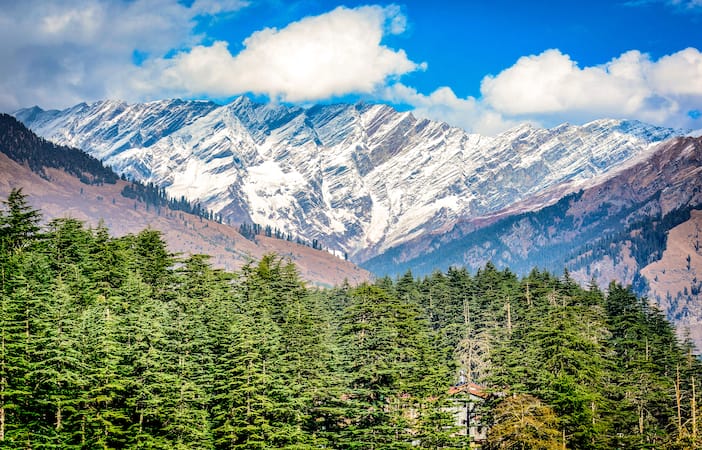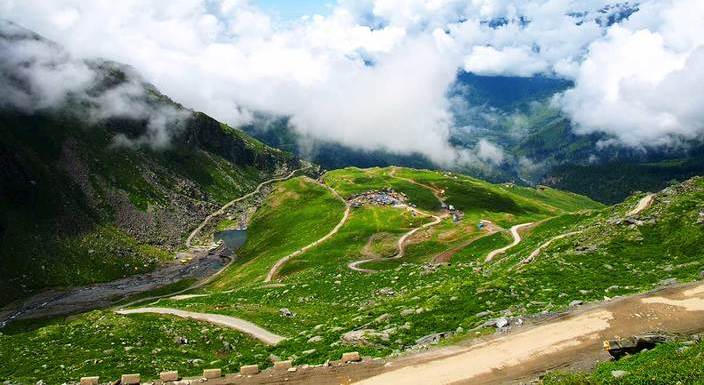Manali

Manali is located at 32.2396 N, 77.1887 E, about 40 km (25 mi) north of Kullu town. The town ranges in elevation from 1,800 m (5,900 ft) to 2,000 m (6,600 ft) in the uppermost Old Manali section.
The climate in Manali is predominantly cold during winter and moderately cool during summer. The temperatures range from 4 °C (39 °F) to 26 °C (79 °F) over the year. The average temperature during summer is between 10 °C (50 °F) and 26 °C (79 °F), and between −15 °C (5 °F) and 12 °C (54 °F) in the winter.
Monthly precipitation varies between 31 mm (1.2 in) in November and 217 mm (8.5 in) in July. On average, some 45 mm (1.8 in) of precipitation is received during winter and spring months, increasing to some 115 mm (4.5 in) in summer as the monsoon approaches. The average total annual precipitation is 1,363 mm (53.7 in). Manali experiences snowfall predominantly between December and beginning of March. The month of January is when it is usually the highest.

Manali is named after the Sanatan Hindu lawgiver Manu. The name Manali is regarded as the derivative of 'Manu-Alaya' which literally means 'the abode of Manu'. Legend has it that sage Manu stepped off his ark in Manali to recreate human life after a great flood had deluged the world. Manali lies in the North of Kullu Valley. The valley is often referred to as the 'Valley of the Gods'. Old Manali village has an ancient temple dedicated to sage Manu.
The British introduced apple trees in the area. The first apple orchard was set up by the British near Patlikuhl, prior to this no Apple trees grew in the area. To this day, apple—along with plum and pear—remain the best source of income for the majority of inhabitants. Both Rainbow and Brown Trout was also introduced into the rivers and streams of the area by the colonisers.
Before other luminaries started visiting Manali, India's first Prime Minister Jawaharlal Nehru favoured this as a holiday destination in the mountains.[citation needed]
With the increase in disposable incomes and somewhat owing to the rise of disturbances in Kashmir in the late 1980s, Manali witnessed a surge in tourist traffic. This once quiet village was transformed into a bustling town with numerous homestays as well as the occasional boutique hotel. During the warmer summer months, cafes and restaurants can be seen doing brisk business.

 Manali has witnessed a flurry of activity related to hydroelectric power and tourism. Unplanned and rampant construction has led to severe depletion of forests and pollution of river bodies, along with garbage being disposed on the side of the mountains. There has been a loss of habitat to various species of fauna, not limited to the Himalayan Monal, incidentally the state bird of Himachal Pradesh. This prompted the National Green Tribunal to intervene and limit vehicular movement on the popular Manali - Rohtang Pass highway, as well as Solang Valley. This has somewhat arrested the damage, however, a lot stillneeds to be done.
Manali has witnessed a flurry of activity related to hydroelectric power and tourism. Unplanned and rampant construction has led to severe depletion of forests and pollution of river bodies, along with garbage being disposed on the side of the mountains. There has been a loss of habitat to various species of fauna, not limited to the Himalayan Monal, incidentally the state bird of Himachal Pradesh. This prompted the National Green Tribunal to intervene and limit vehicular movement on the popular Manali - Rohtang Pass highway, as well as Solang Valley. This has somewhat arrested the damage, however, a lot stillneeds to be done.
No comments:
Post a Comment